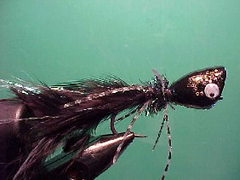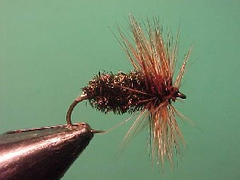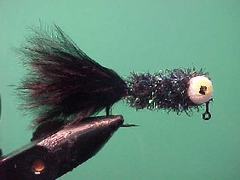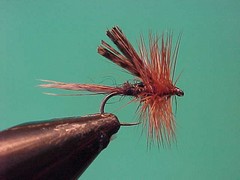Species
{{start}}
{{end}}

{{+1}}Popper – poly head{{-1}}
{{start}}
If I could only carry one surface fly when fishing for Bass, Yellow belly and other native species my black Poll-Head-Popper would be it. They a definite "boof"as the fly lands and that is often enough to induce a strike.{{end}}

{{+1}}Fried honey and soy trout{{-1}}
{{start}}
You can cook trout in many ways but unless you add some zing you will find that its often a bit flat. This is my personal favorite fried trout recipe.{{end}}

{{+1}}Coch-Y-Bonddu{{-1}}
{{start}}
The Cock-Y-Bonddu is a Welsh beetle pattern which is equally at home on Australian trout waters. The original was tied with flat silver tinsel wound around the hook shank just behind the body. This little bit of flash isn't intended to represent a tail its more likely that it was included to imitate the beetle wing parts that often trail behind a beetle like a tail when it gets trapped in the water mid flight.{{end}}

{{+1}}Booby – traditional booby{{-1}}
{{start}}
With the tow point at the tip of the 90 degree stem any forward movement of the fly raises the fly up a little and a steady forward movement of the fly creates a very natural wake. If just twitched it creates circles reminiscent of a struggling terrestrial insect.{{end}}

{{+1}}Red and orange spinner{{-1}}
{{start}}
The term 'spinner' refers to that stage in a Dun's life cycle when it has moved off the water or, vegetation etc. after drying its wings. The adult or imago of all Mayflies, Caddis flies and Midges can technically be regarded as spinners. The following Spinner is a generic representation for members of the “Leptophlebiidae” family of Mayflies and the various Highland Duns & Spinners, which are members of the “Oniscigastridae” family. Hatches generally occurs between the months of October and March. Carry black, brown, red and blue damsel versions.{{end}}

{{+1}}Irresistible{{-1}}
{{start}}
The Adams Irresistible is just one representation of a Baetis Dun. It floats like a cork and what's more fish accept it as a variety of food items. In smaller sizes it is an excellent Baetis Dun imitation and an excellent fly in still water particularly when Snow Flake Caddis are about. In larger sizes it is an excellent fly for fast water or as a top fly in dry / nymph combination. Change the material colours to tie flies representing Baetis Duns in your target fishery. I carry Adams, black, brown and olive versions in a couple of sizes.{{end}}

{{+1}}Lepto Dun{{-1}}
{{start}}
I use this fly to represent mayflies that are members of the Leptophlebiidae classification of mayflies which includes the Highland Dun and Olive Dun and also the Kosciuszko Dun which is a member of the Coloburiscidae classification of the Mayfly family.{{end}}

{{+1}}Black & peacock{{-1}}
{{start}}
Flies that represent spiders and beetles are very buggy and suggestive flies. Weather being used as a polaroiding fly, a static wet, one of the flies in a team of loch style flies, or a fly to cover rising fish spider type soft hackle flies may be taken as a snail, submerged beetle, drowned terrestrial, diving beetle or even a carixia.{{end}}

{{+1}}Red Tag{{-1}}
{{start}}
The red tag is as relevant today as when it was first invented some 140 years ago. It is perhaps the quintessential beetle imitation and is popular worldwide.{{end}}

{{+1}}Caenis Dun{{-1}}
{{start}}
If you have a look at Caenis Duns there are fundamentals of shape that are common across the species and captured by this pattern. The tail consists of only three filaments; the body starts thin and is then cigar shaped with 9 distinct segments. They have 6 legs and wings faces back at about a 60 degree angle. The common colours are grey and brown and when they are hatching the vision is of very small single winged sailing boats on the water.{{end}}













